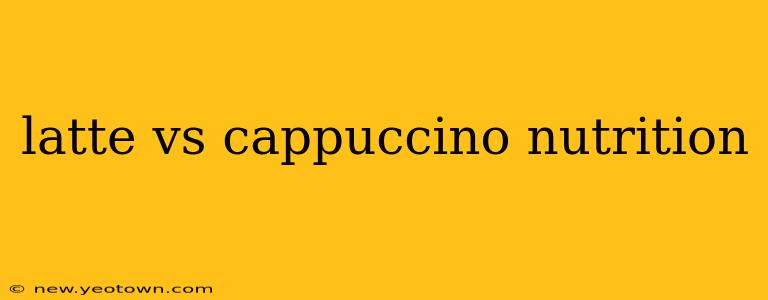Latte vs. Cappuccino: A Nutritional Showdown
The aroma of freshly brewed coffee, the creamy texture, the gentle warmth… ah, the simple pleasures of a latte or a cappuccino! But beyond the delightful sensory experience lies a question many coffee lovers ponder: what's the nutritional difference between a latte and a cappuccino? Let's dive into this caffeinated comparison, exploring the subtle yet significant nutritional variations.
Our story begins, as many do, in a bustling Italian cafe. Imagine two friends, Maria and Giovanni, each ordering their favorite coffee beverage. Maria, a lover of all things rich and creamy, opts for a large latte. Giovanni, preferring a more robust, slightly less milky experience, chooses a cappuccino. Their seemingly simple choices actually reveal a fascinating nutritional contrast.
What's the difference in calories?
This is often the first question people ask when comparing these two coffee drinks. Generally, a latte tends to have more calories than a cappuccino. This is primarily due to the difference in the milk-to-espresso ratio. Lattes typically have a higher proportion of steamed milk to espresso, leading to a higher calorie count. A grande latte from a popular coffee chain might clock in around 190-250 calories, whereas a comparable cappuccino could contain 150-200 calories. However, this can vary greatly depending on the size of the drink, the type of milk used (whole milk versus skim milk will make a significant difference), and the addition of any syrups or flavorings.
How much caffeine is in each drink?
This is another frequently asked question, and the answer here is less straightforward. Both lattes and cappuccinos typically contain a similar amount of caffeine, as they both usually include a shot or two of espresso. The caffeine content will depend mainly on the strength of the espresso shot used. The milk, regardless of the volume, doesn't directly affect the caffeine level. So, Maria and Giovanni likely received roughly the same caffeine boost, though the perceived "kick" might differ due to other factors like individual metabolism.
Are there differences in fat and protein?
The significant difference between these drinks lies in their fat and protein content. Because of the greater volume of milk in a latte, it generally contains more fat and protein than a cappuccino. Again, the type of milk is crucial here. A latte made with whole milk will be significantly higher in fat and saturated fat compared to one made with skim or almond milk. Giovanni's cappuccino, even with whole milk, will likely have a slightly lower overall fat content due to the smaller milk volume. The protein content follows a similar pattern: more milk equals more protein, but the type of milk significantly influences the amount.
What about carbohydrates and sugar?
The carbohydrate content in both beverages primarily comes from the milk. Lattes, having more milk, will naturally have a slightly higher carbohydrate count than cappuccinos. It's essential to remember that added syrups or flavored toppings dramatically increase the sugar and carbohydrate content in both drinks, so opting for unsweetened options is always healthier.
Which drink is healthier?
Ultimately, the "healthier" option depends on individual dietary needs and preferences. A cappuccino made with skim milk could be considered slightly healthier due to its lower calorie, fat, and carbohydrate content. However, a latte made with unsweetened almond milk or oat milk could actually be a healthier choice in terms of reduced fat and potentially higher fiber. The key is mindful consumption and making informed choices about milk type and added sugars. Both Maria and Giovanni could enjoy their coffee without compromising their health too much with careful consideration of the ingredients.
In the end, whether you're a latte loyalist like Maria or a cappuccino connoisseur like Giovanni, savoring your coffee responsibly is key. Understanding the subtle differences in nutrition allows for more informed choices, ensuring your coffee break is not only enjoyable but also aligns with your health goals.

